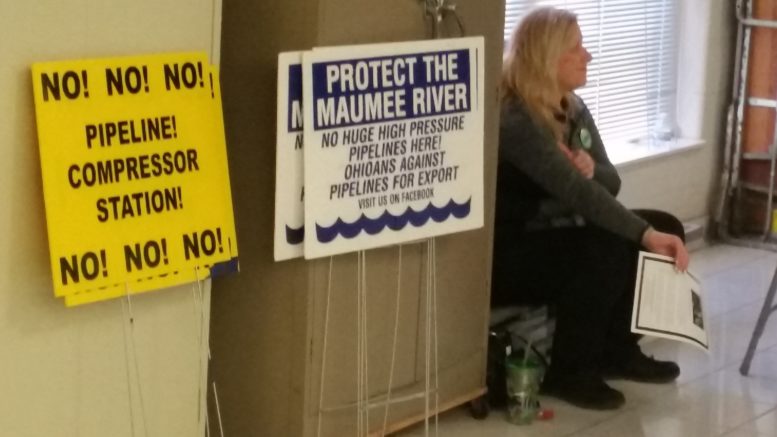(Submitted by UC4POWER)
On Wednesday, February 1, 2017 a group of residents from Bowling Green and Waterville, Ohio joined the opposition against the proposed NEXUS natural gas pipeline in a federal licensing case, and demanded that the Federal Energy Regulatory Agency (FERC) not take hasty action to grant a requested federal permit.
The citizen coalition, United Communities for Protecting our Water and Elevating Power (“UC4POWER”), filed a motion to intervene at FERC, claiming “high risk” from planned construction of the pipeline just south of Waterville because of a gross lack of understanding of several geological realities and their interrelationships. The pipeline would be built across the Bowling Green Fault, a major seismic crack in the Earth’s crust. The group maintains that the final environmental report for the pipeline, written by FERC, mistakenly identifies the Fault as being buried 2,200 feet or more beneath the surface and does not admit that the Fault is visible at the surface. But a hydrogeologist and environmental policy expert for UC4POWER, Dr. Andrew Kear of Bowling Green State University, advises that “Due to its close proximity to the Bowling Green Municipal Water supply the potential contamination by drilling fluids, earthquakes due to fault lubrication, and leaks during operation, the pipeline poses a serious and unnecessary public health threat. It could contaminate a regional drinking water supply, the Maumee River, and Lake Erie.”
The pipeline would intersect with the BG Fault within 800 feet of the Bowling Green Water Treatment Facility before passing 90 feet underneath the Maumee River, within half a mile of an active blasting limestone quarry, through expected karst formations. “From a risk assessment perspective,” stated Dr. Kear, “one would be hard pressed to pick a location that threatens public health and safety more than this location does.” Dr. Kear drew some of his conclusions of serious geological danger from a study performed by a NEXUS consultant which found that “Due to subsurface conditions, the risk level associated with the proposed crossing of the Maumee River is high.” The pipeline would be installed in a tunnel underneath the Maumee River bed through karst geology, a fragile system of openings and caverns where the bedrock is prone to crumble and collapse. Because of the proximity of an active blasting quarry on the edge of Waterville, the nearness of the BG Fault, and the danger a geological failure could cause to the City of Bowling Green’s water intake and treatment plant across the river from Waterville, Dr. Kear found that cautious analysis is necessary.
UC4POWER also submitted a letter to FERC on February 1, opposing a request by NEXUS for accelerated approval by February 3 of its federal permit application. UC4POWER requests that FERC delay its ruling on the Nexus Certificate of Public Convenience and Necessity until after the Commission has regained a quorum of appointed members. Commissioner Norman Bay’s recent resignation will take effect on Friday, February 3, 2017, leaving the Commission with only two Board members, not enough to issue permits. FERC is supposed to have a five member board.
UC4POWER sees expanded opposition as needed because of the failure of FERC as regulator to protect the public because of poor oversight and scientific misinterpretation of the geology. “For two years federal and state officials have kept the facts and implications about these pipeline hazards to themselves,” said Lisa Kochheiser, coalition coordinator. “Local citizens are no longer willing to leave it to a suspect agency which has been fed misinformation by the pipeline company to make decisions. We have been kept in the dark long enough. It’s time to expose the facts to stop the pipeline and hold corporations, regulatory agencies, and officials accountable.”
UC4POWER will hold a rally near the pipeline’s planned river crossing next week to present Dr. Kear’s findings to residents. Details will be publicized soon.

